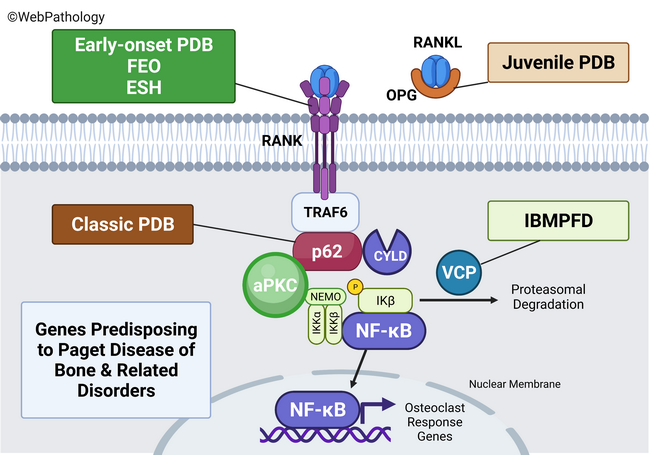Paget Disease of Bone : Pathogenesis


Comments:
Genetics of Paget Disease of Bone (PDB): Genome-wide linkage scans have identified several susceptibility loci that increase the risk of PDB. Mutations in the following genes have been found in patients with PDB and related disorders. All of them are associated with RANK-NF-κB signaling pathway which is crucial for normal osteoclastogenesis. TNFRSF11A: This gene on chromosome 18q21 codes for a surface receptor called RANK (receptor activator of nuclear factor-kappa B) on osteoclast precursors. It is a member of TNF superfamily and plays a critical role in differentiation and maturation of osteoclasts. Several PDB-like syndromes, including early-onset familial PDB, familial expansile osteolysis (FEO), and expansile skeletal hyperphosphatasia (ESH) are caused by insertion mutations in TNFRSF11A.
TNFRSF11B: This gene codes for osteoprotegerin (OPG) - a soluble glycoprotein synthesized by osteoblasts that acts as a key regulator of osteoclastic bone resorption. It belongs to the TNF receptor superfamily and lacks an intracellular domain. It acts as a decoy receptor for RANKL, thereby inhibiting RANK-RANKL binding, and shutting down NF-κB signaling pathway. Inactivating mutations in TNFRSF11B cause the rare juvenile variant of PDB - an autosomal recessive condition characterized by high bone turnover and bone deformity, with onset in early teens. SQSTM1: SQSTM1 gene on chromosome 5q35.3 encodes a 440-amino acid scaffold protein called Sequestosome 1 (aka p62). Mutations in SQSTM1 increase osteoclast activity by impairing the ability of p62 to bind CYLD - a negative regulator of NF-κB signaling pathway. SQSTM1 mutations have been found in 50% of familial cases and 5-10% of sporadic cases of PDB. VCP: This gene encodes Valosin-containing protein (aka p97) - an ATPase that is part of ubiquitin-proteasome system. It plays a role in targeting the inhibitor of NF-κB for degradation by proteasome. Mutations in VCP cause the rare hereditary (autosomal dominant) syndrome of inclusion body myopathy, PDB, and fronto-temporal dementia (IBMPFD). Reference: Daroszewska A, Ralston SH. Mechanisms of Disease: Genetics of Paget's Disease of Bone and Related Disorders. Nature Clinical Practice Rheumatology 2006; Vol. 2; pp. 270-277. Credit: Illustration created with BioRender.com



